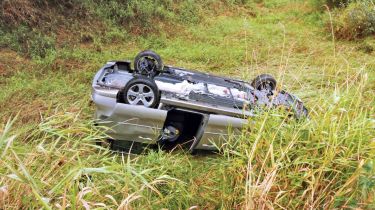
Cat N and Cat S insurance write-off categories are applied to vehicles which have previously sustained either cosmetic or structural damage as a result of an accident. The damage caused will have resulted in an insurance claim, and the car being designated as an insurance write-off.
Some cars which haven’t sustained serious structural damage and are deemed safe to repair and can return to the road after being written off by the insurance company. These cars are designated Cat N or Cat S, so they can legally be sold on the open market. Any cars deemed too badly damaged and not fit to be returned to the road will be designated Cat A or Cat B, these cars can’t be sold and must be scrapped.
Unlike a Cat A or Cat B car, you can buy a used Cat N or Cat S car, but should you do so? There are potential risks involved in purchasing any write-off and you should certainly use extra caution. We cover all the key points to consider in detail below.
What is an insurance write-off?
A car is deemed an insurance write-off following an insurance claim. The claim might result from an accident on the road or damage to the car as a result of fire, flood, vandalism or theft. The insurance company will then assess the extent of the cosmetic or structural damage to judge if the car is worth repairing.
Should the insurance assessor find that the repair work required would be uneconomical, as the cost of repairs would be more than the value of the repaired car, they will assign a car an insurance write-off category. This indicates the extent of the damage and the nature of any repairs that will need to be carried out to make the car roadworthy again. The write-off category must be declared by anyone selling the car in the future and gives potential buyers an extra indication as to what to look out for.
In 2017, Cat N and Cat S replaced the older Cat C and Cat D categories to help better represent the complexity involved in repairing modern cars. If you are searching for a used car, it is important to note that old cars that were originally assessed through the old system prior to October 2017 won’t be reassessed so they may still have Cat C or D classifications.
What is Cat N damage?
The Cat N insurance write-off classification encompasses all non-structural damage to elements such as body panels, lights, and electrical systems. Cat N vehicles can be put back on the road, and while they do not need to be re-registered with the DVLA, you will still need to inform the DVLA your car has been written-off in the first place.
What is Cat S damage?
A Cat S car is one which has sustained structural damage – think of items integral to the car’s structure such as the chassis and suspension. While Cat S cars can safely be repaired and put back on the road, they must be re-registered with the DVLA beforehand.
Need to sell your car?
Find your best offer from over 5,000+ dealers. It’s that easy.
In effect, Cat N and Cat S replace the old Cat D and Cat C categories respectively, albeit with slight modifications to their remits to represent the complexities of modern cars.
What does Cat S and Cat N damage mean for buyers?
The write-off categories are intended to reflect the type of damage sustained by a car that caused it to be written off. Knowing this information will go some way towards helping any potential future buyers understand what to look for when inspecting the car. Knowing that a car was previously structurally damaged is particularly important, as poor repairs can be easier to hide from all but the most thorough of inspections and could become costly or problematic later down the line.
Conducting a background check, such as those undertaken by Hire Purchase Investigation (HPI), should also reveal this categorisation as an alert on the car’s history. The registration certificate – the V5C – will also be marked with an ‘S’ to signify that the car has been salvaged.
Any seller is required to disclose any past write-off status of the vehicle but conducting a background check, such as those undertaken by Hire Purchase Investigation (HPI), should reveal this categorisation as an alert on the car’s history. The registration certificate, known as the V5C, will also be marked with an ‘S’ to signify that the car has been salvaged.
What are Cat A and Cat B cars?
If a car is damaged beyond the point that an insurer believes it can be safely returned to the road, it will be classified as either Cat A or Cat B. Cat A cars have to be crushed, and none of their parts can ever legally be reused. Cat B (the ‘B’ stands for ‘break’) cars also have to have their body shells crushed, but can be broken up for parts before that happens, with salvageable components being resold.
Insurance write-off categories at a glance
- A. Scrap
- B. Break
- S. Structurally damaged repairable
- N. Non-structurally damaged repairable
Should I buy a Cat S or Cat N car?
The same caveats apply to Cat N or Cat S cars as apply to the old Cat C and Cat D vehicles: buyer beware.
Firstly, conducting a HPI background check on a car should show whether it has ever been declared as a write-off. Some sellers try to pass off a Cat N or Cat S car off as a non-damaged car, despite a seller being legally required to inform a potential buyer of this fact, so if they fail to do so, walk away as they could be trying to illegally cover up the vehicle’s past.
Once you have determined a car’s history, it’s important to be sure of the standard of all repairs carried out when the car was returned to the road. If you are viewing a potential write-off purchase, it is a very good idea to get a professional inspection before signing any paperwork or parting with any money – this is particularly important with structurally-damaged Cat S cars.
Another thing to be aware of is that insurance can be harder to come by for previously written-off cars, with some providers not covering them at all. While this can be overcome by hunting around, insurance for Cat S and N cars (likewise for C and D) tends to be more expensive than it is for non-written-off cars.
Written-off cars are also worth less than their undamaged counterparts. While this should be reflected in their purchase price, you may find it hard to sell a Cat S or Cat N car, as some buyers will simply not consider them.
Looking for a used bargain? Take a look at our best cars for £5,000 or less and get personalised car insurance quotes using our tool…

